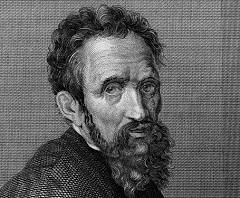

Michelangelo (1475–1564) was a prolific Italian sculptor, painter, architect, and poet of the High Renaissance who is considered one of the greatest artists of all time. Born in Caprese, Italy, his famous works include the sculptures David and Pietà, and the Sistine Chapel ceiling frescoes, which showcase his profound understanding of human anatomy and emotional expression. Influenced by classical antiquity and the patronage of the Medici family, his career spanned over 70 years and had a lasting impact on Western art.
Early life and training
- Born on March 6, 1475, in Caprese, Italy, Michelangelo moved to Florence with his family shortly after his birth.
- Despite his father’s disapproval of an artistic career, Michelangelo’s talent led him to be apprenticed to the painter Domenico Ghirlandaio at age 13.
- He later studied under the patronage of the Medici family, where he gained access to a collection of ancient Roman sculptures that heavily influenced his work.
Key artistic achievements
- Sculpture: His masterpieces include the Pietà (completed in 1499) and the iconic statue of David (completed in 1504), which demonstrated a new level of anatomical realism and emotional depth.
- Painting: He was commissioned by Pope Julius II to paint the ceiling of the Sistine Chapel in Rome, a monumental project completed between 1508 and 1512 that features 343 figures, including the famous Creation of Adam. He later created The Last Judgment on the chapel’s altar wall.
- Architecture: He became the chief architect for St. Peter’s Basilica in 1546, where he redesigned the dome, a structure that influenced future church architecture.
- Poetry: He was also a gifted poet, writing sonnets and madrigals that explored spiritual and humanistic themes.
Later life and legacy
- Michelangelo was known for his intense dedication to his art and was revered by his contemporaries as “Il Divino” (The Divine One).
- He continued to work on various projects, including the tomb for Pope Julius II and his architectural designs for St. Peter’s Basilica, until his death in Rome on February 18, 1564.
- His work had a profound and lasting influence on Western art, impacting the development of styles like Mannerism and the Baroque.
Leave a Reply